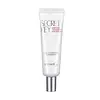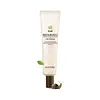What's inside
What's inside
 Key Ingredients
Key Ingredients

 Benefits
Benefits

 Concerns
Concerns

 Ingredients Side-by-side
Ingredients Side-by-side

Water
Skin ConditioningGlycerin
HumectantHydrogenated Polyisobutene
EmollientAluminum Starch Octenylsuccinate
AbsorbentGlyceryl Stearate Se
EmulsifyingNiacinamide
SmoothingC12-15 Alkyl Benzoate
AntimicrobialPolyglyceryl-3 Methylglucose Distearate
EmulsifyingCyclopentasiloxane
EmollientBeeswax
Emulsion StabilisingGalactomyces Ferment Filtrate
HumectantSodium Polyacrylate
AbsorbentAcrylates/C10-30 Alkyl Acrylate Crosspolymer
Emulsion StabilisingGlyceryl Polyacrylate
Stearic Acid
CleansingButyrospermum Parkii Butter
Skin ConditioningAdenosine
Skin ConditioningAloe Barbadensis Leaf Extract
EmollientAnthemis Nobilis Flower Extract
MaskingCamellia Sinensis Leaf Extract
AntimicrobialCentella Asiatica Extract
CleansingBoswellia Serrata Resin Extract
SmoothingHamamelis Virginiana Extract
AntiseborrhoeicOryza Sativa Extract
AbsorbentPortulaca Oleracea Extract
Skin ConditioningPanax Ginseng Root Extract
EmollientAcanthopanax Senticosus Root Extract
Skin ConditioningSh-Oligopeptide-1
Skin ConditioningLecithin
EmollientSodium Ascorbyl Phosphate
AntioxidantMacadamia Integrifolia Seed Oil
Skin ConditioningPrunus Amygdalus Dulcis Oil
Skin ConditioningArgania Spinosa Kernel Oil
EmollientAstrocaryum Murumuru Seed Butter
EmollientSimmondsia Chinensis Seed Oil
EmollientCeramide NP
Skin ConditioningTocopheryl Acetate
AntioxidantCaprylhydroxamic Acid
Caprylyl Glycol
Emollient1,2-Hexanediol
Skin ConditioningTriethanolamine
BufferingDisodium EDTA
Parfum
MaskingWater, Glycerin, Hydrogenated Polyisobutene, Aluminum Starch Octenylsuccinate, Glyceryl Stearate Se, Niacinamide, C12-15 Alkyl Benzoate, Polyglyceryl-3 Methylglucose Distearate, Cyclopentasiloxane, Beeswax, Galactomyces Ferment Filtrate, Sodium Polyacrylate, Acrylates/C10-30 Alkyl Acrylate Crosspolymer, Glyceryl Polyacrylate, Stearic Acid, Butyrospermum Parkii Butter, Adenosine, Aloe Barbadensis Leaf Extract, Anthemis Nobilis Flower Extract, Camellia Sinensis Leaf Extract, Centella Asiatica Extract, Boswellia Serrata Resin Extract, Hamamelis Virginiana Extract, Oryza Sativa Extract, Portulaca Oleracea Extract, Panax Ginseng Root Extract, Acanthopanax Senticosus Root Extract, Sh-Oligopeptide-1, Lecithin, Sodium Ascorbyl Phosphate, Macadamia Integrifolia Seed Oil, Prunus Amygdalus Dulcis Oil, Argania Spinosa Kernel Oil, Astrocaryum Murumuru Seed Butter, Simmondsia Chinensis Seed Oil, Ceramide NP, Tocopheryl Acetate, Caprylhydroxamic Acid, Caprylyl Glycol, 1,2-Hexanediol, Triethanolamine, Disodium EDTA, Parfum
Water
Skin ConditioningCetearyl Alcohol
EmollientMacadamia Ternifolia Seed Oil
EmollientNiacinamide
SmoothingButylene Glycol
HumectantSteareth-2
EmulsifyingSqualane
EmollientBear Oil
EmollientHydrogenated Cottonseed Oil
EmollientSteareth-21
CleansingCetyl Alcohol
EmollientAbies Alba Seed Extract
AntimicrobialBeta-Glucan
Skin ConditioningSimmondsia Chinensis Seed Oil
EmollientPanthenol
Skin ConditioningHydrogenated Palm Oil
EmollientOligopeptide-1
Skin ConditioningSaccharomyces/Caragana Sinica Root Ferment Extract
AntioxidantDimethicone
EmollientPropylene Glycol
HumectantLecithin
EmollientPropylparaben
PreservativeParfum
MaskingWater, Cetearyl Alcohol, Macadamia Ternifolia Seed Oil, Niacinamide, Butylene Glycol, Steareth-2, Squalane, Bear Oil, Hydrogenated Cottonseed Oil, Steareth-21, Cetyl Alcohol, Abies Alba Seed Extract, Beta-Glucan, Simmondsia Chinensis Seed Oil, Panthenol, Hydrogenated Palm Oil, Oligopeptide-1, Saccharomyces/Caragana Sinica Root Ferment Extract, Dimethicone, Propylene Glycol, Lecithin, Propylparaben, Parfum
Ingredients Explained
These ingredients are found in both products.
Ingredients higher up in an ingredient list are typically present in a larger amount.
Lecithin is a term for a group of substances found in the cell membranes of plants, animals, and humans. They are made up of mixture of phospholipids.
This ingredient has emollient and emulsifying properties.
As an emollient, lecithen helps soften the skin and creates a barrier to keep moisture in.
As an emulsifier, it also helps prevent water and oil ingredients from separating. Lecithin can also help ingredients be better absorbed by the skin.
This is because the phospholipids in lecithin produce liposomes. Liposomes help other ingredients get through the skin barrier.
Depending on the source of this ingredient, lecithin may not be fungal acne safe. This is because some sources of lecithin come from soybean oil, which may feed the malassezia yeast that feeds fungal acne.
We recommend reaching out to the brand you are purchasing from to inquire about the source of their lecithin.
Some other names for this ingredient include soy lecithin and deoiled soy lecithin.
Learn more about LecithinNiacinamide is a multitasking form of vitamin B3 that strengthens the skin barrier, reduces pores and dark spots, regulates oil, and improves signs of aging.
And the best part? It's gentle and well-tolerated by most skin types, including sensitive and reactive skin.
You might have heard of "niacin flush", or the reddening of skin that causes itchiness. Niacinamide has not been found to cause this.
In very rare cases, some individuals may not be able to tolerate niacinamide at all or experience an allergic reaction to it.
If you are experiencing flaking, irritation, and dryness with this ingredient, be sure to double check all your products as this ingredient can be found in all categories of skincare.
When incorporating niacinamide into your routine, look out for concentration amounts. Typically, 5% niacinamide provides benefits such as fading dark spots. However, if you have sensitive skin, it is better to begin with a smaller concentration.
When you apply niacinamide to your skin, your body converts it into nicotinamide adenine dinucleotide (NAD). NAD is an essential coenzyme that is already found in your cells as "fuel" and powers countless biological processes.
In your skin, NAD helps repair cell damage, produce new healthy cells, support collagen production, strengthen the skin barrier, and fight environmental stressors (like UV and pollution).
Our natural NAD levels start to decline with age, leading to slower skin repair, visible aging, and a weaker skin barrier. By providing your skin niacinamide, you're recharging your skin's NAD levels. This leads to stronger, healthier, and younger looking skin.
Another name for vitamin B3 is nicotinamide. This vitamin is water-soluble and our bodies don't store it. We obtain Vitamin B3 from either food or skincare. Meat, fish, wheat, yeast, and leafy greens contain vitamin B3.
The type of niacinamide used in skincare is synthetically created.
Learn more about NiacinamideParfum is a catch-all term for an ingredient or more that is used to give a scent to products.
Also called "fragrance", this ingredient can be a blend of hundreds of chemicals or plant oils. This means every product with "fragrance" or "parfum" in the ingredients list is a different mixture.
For instance, Habanolide is a proprietary trade name for a specific aroma chemical. When used as a fragrance ingredient in cosmetics, most aroma chemicals fall under the broad labeling category of “FRAGRANCE” or “PARFUM” according to EU and US regulations.
The term 'parfum' or 'fragrance' is not regulated in many countries. In many cases, it is up to the brand to define this term.
For instance, many brands choose to label themselves as "fragrance-free" because they are not using synthetic fragrances. However, their products may still contain ingredients such as essential oils that are considered a fragrance by INCI standards.
One example is Calendula flower extract. Calendula is an essential oil that still imparts a scent or 'fragrance'.
Depending on the blend, the ingredients in the mixture can cause allergies and sensitivities on the skin. Some ingredients that are known EU allergens include linalool and citronellol.
Parfum can also be used to mask or cover an unpleasant scent.
The bottom line is: not all fragrances/parfum/ingredients are created equally. If you are worried about fragrances, we recommend taking a closer look at an ingredient. And of course, we always recommend speaking with a professional.
Learn more about ParfumThis oil comes from the seeds of the desert shrub called Jojoba. It is more commonly known as jojoba oil, a non-comedogenic oil.
Jojoba oil does not contain fragrance and has many fatty-acids, making it a great soothing ingredient.
It also contains Vitamin E, a great moisturizing ingredient. Vitamin E is also an antioxidant and protects your skin against oxidative damage.
This ingredient humectant properties, meaning it helps draw moisture from the air. This helps keep your skin hydrated.
While jojoba has antibacterial properties, it is only able to kill some strains of bacteria.
Studies also show it helps in wound healing. In fact, Indigenous cultures have used jojoba as a moisturizer and to help treat burns for centuries.
Fun fact: Jojoba oil similar to natural human skin sebum, so it has a great effect on dry skin. It is also promising with helping to regulate sebum production.
Due to its fatty acid content, Jojoba oil may not be fungal acne safe. We recommend speaking with a professional if you have any concerns.
Learn more about Simmondsia Chinensis Seed OilWater. It's the most common cosmetic ingredient of all. You'll usually see it at the top of ingredient lists, meaning that it makes up the largest part of the product.
So why is it so popular? Water most often acts as a solvent - this means that it helps dissolve other ingredients into the formulation.
You'll also recognize water as that liquid we all need to stay alive. If you see this, drink a glass of water. Stay hydrated!
Learn more about Water